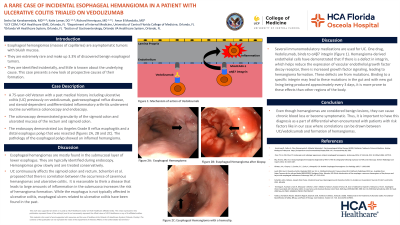Sunday Poster Session
Category: General Endoscopy
P0577 - A Rare Case of Incidental Esophageal Hemangioma in a Patient With Ulcerative Colitis Trialed on Vedolizumab
Sunday, October 22, 2023
3:30 PM - 7:00 PM PT
Location: Exhibit Hall

Has Audio
- SK
Sesha Sai Kanakamedala, MBBS
University of Central Florida College of Medicine
Orlando, FL
Presenting Author(s)
Sesha Sai Kanakamedala, MBBS1, Katie Lamar, MD2, Amar B Mandalia, MD1, Richard Henriquez, MD1
1University of Central Florida College of Medicine, Orlando, FL; 2UCF COM/HCA Healthcare GME, Orlando, FL
Introduction: Esophageal hemangiomas (masses of capillaries) are asymptomatic tumors with bluish mucosa. They are extremely rare and make up 3.3% of discovered benign esophageal tumors. They are identified incidentally, and little is known about the underlying cause. This case presents a new look at prospective causes of their formation.
Case Description/Methods: A 75-year-old veteran with a past medical history of ulcerative colitis (UC) previously on Vedolizumab, gastroesophageal reflux disease, and steroid-dependent undifferentiated inflammatory arthritis underwent routine surveillance colonoscopy and endoscopy. The colonoscopy demonstrated granularity of the sigmoid colon and ulcerated mucosa of the rectum and sigmoid colon; the endoscopy demonstrated Los Angeles Grade B reflux esophagitis and a distal esophagus polyp that was resected. The pathology of the esophageal polyp showed an inflamed hemangioma.
Discussion: Esophageal hemangiomas are mostly found in the submucosal layer of lower esophagus. They are typically identified during endoscopy. Hemangiomas grow slowly and are treated conservatively.
UC continuously affects the sigmoid colon and rectum. Schembri et al. proposed that there is correlation between the occurrence of cavernous hemangiomas and ulcerative colitis. It is reasonable to think a disease that leads to large amounts of inflammation in the submucosa increases the risk of hemangioma formation. While the esophagus is not typically affected in ulcerative colitis, esophageal ulcers related to ulcerative colitis have been found in the past.
Several immunomodulatory medications are used for UC. One drug, Vedolizumab, binds to α4β7 integrin. Hemangioma-derived endothelial cells have demonstrated that if there is a defect in integrin, which helps reduce the expression of vascular endothelial growth factor decoy receptor, there is increased growth factor signaling, leading to hemangioma formation. These defects are from mutations. Binding to a specific integrin may lead to these mutations in the gut and with new gut lining being produced approximately every three days, it is more prone to these effects than other regions of the body.
Even though hemangiomas are considered benign lesions, they can cause chronic blood loss or become symptomatic. Thus, it is important to have this diagnosis as a part of differential when encountered with patients with risk factors like in our case where correlations can be drawn between UC/vedolizumab and formation of hemangiomas.

Disclosures:
Sesha Sai Kanakamedala, MBBS1, Katie Lamar, MD2, Amar B Mandalia, MD1, Richard Henriquez, MD1. P0577 - A Rare Case of Incidental Esophageal Hemangioma in a Patient With Ulcerative Colitis Trialed on Vedolizumab, ACG 2023 Annual Scientific Meeting Abstracts. Vancouver, BC, Canada: American College of Gastroenterology.
1University of Central Florida College of Medicine, Orlando, FL; 2UCF COM/HCA Healthcare GME, Orlando, FL
Introduction: Esophageal hemangiomas (masses of capillaries) are asymptomatic tumors with bluish mucosa. They are extremely rare and make up 3.3% of discovered benign esophageal tumors. They are identified incidentally, and little is known about the underlying cause. This case presents a new look at prospective causes of their formation.
Case Description/Methods: A 75-year-old veteran with a past medical history of ulcerative colitis (UC) previously on Vedolizumab, gastroesophageal reflux disease, and steroid-dependent undifferentiated inflammatory arthritis underwent routine surveillance colonoscopy and endoscopy. The colonoscopy demonstrated granularity of the sigmoid colon and ulcerated mucosa of the rectum and sigmoid colon; the endoscopy demonstrated Los Angeles Grade B reflux esophagitis and a distal esophagus polyp that was resected. The pathology of the esophageal polyp showed an inflamed hemangioma.
Discussion: Esophageal hemangiomas are mostly found in the submucosal layer of lower esophagus. They are typically identified during endoscopy. Hemangiomas grow slowly and are treated conservatively.
UC continuously affects the sigmoid colon and rectum. Schembri et al. proposed that there is correlation between the occurrence of cavernous hemangiomas and ulcerative colitis. It is reasonable to think a disease that leads to large amounts of inflammation in the submucosa increases the risk of hemangioma formation. While the esophagus is not typically affected in ulcerative colitis, esophageal ulcers related to ulcerative colitis have been found in the past.
Several immunomodulatory medications are used for UC. One drug, Vedolizumab, binds to α4β7 integrin. Hemangioma-derived endothelial cells have demonstrated that if there is a defect in integrin, which helps reduce the expression of vascular endothelial growth factor decoy receptor, there is increased growth factor signaling, leading to hemangioma formation. These defects are from mutations. Binding to a specific integrin may lead to these mutations in the gut and with new gut lining being produced approximately every three days, it is more prone to these effects than other regions of the body.
Even though hemangiomas are considered benign lesions, they can cause chronic blood loss or become symptomatic. Thus, it is important to have this diagnosis as a part of differential when encountered with patients with risk factors like in our case where correlations can be drawn between UC/vedolizumab and formation of hemangiomas.

Figure: A. Esophageal hemangioma, B. Esophageal hemangioma with a clip, C. Esophageal hemangioma after biopsy.
Disclosures:
Sesha Sai Kanakamedala indicated no relevant financial relationships.
Katie Lamar indicated no relevant financial relationships.
Amar B Mandalia indicated no relevant financial relationships.
Richard Henriquez indicated no relevant financial relationships.
Sesha Sai Kanakamedala, MBBS1, Katie Lamar, MD2, Amar B Mandalia, MD1, Richard Henriquez, MD1. P0577 - A Rare Case of Incidental Esophageal Hemangioma in a Patient With Ulcerative Colitis Trialed on Vedolizumab, ACG 2023 Annual Scientific Meeting Abstracts. Vancouver, BC, Canada: American College of Gastroenterology.
